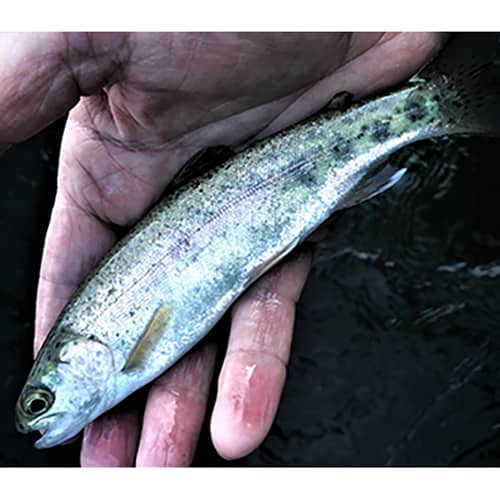What is it and how does it work?
Pacific salmon and steelhead demonstrate an anadromous life history. The word anadromous comes from Greek, meaning “running up”. Anadromous fish spawn in freshwater. The juvenile progeny rear in freshwater and then migrate to the ocean. They eventually return to freshwater to spawn. Most anadromous salmonids return to the stream where they reared as a juvenile fish. Juvenile salmon and steelhead undergo a process called smoltification at the end of their freshwater rearing period.
During juvenile steelhead smoltification, the fish undergoes morphological, physiological, behavioral, and biochemical changes. Juvenile fish, now called a “parr” at this stage, have a series of oval or round dark colored areas on the sides during freshwater rearing.
The shape, number and positioning of the marks are unique to each species. This helps identify juvenile rainbow trout from other salmonids. During smoltification, the parr marks become visually obstructed due to the formation of needle-like crystals. These are deposited directly beneath the scales and deep in the dermis or skin adjacent to the muscles. The crystals produce the silvery appearance of the fish. During smoltification the fish also becomes streamline, scales become loose, and fin margins darken. Eventually the juvenile fish transforms from the darkly pigmented parr into a silvery “smolt” prepared for the transition into seawater.
Anadromy
It is unclear whether anadromy in rainbow trout is a genetic adaptation or a behavior related to environmental conditions. More likely, it is a combination of both. Not all of the young of steelhead parents will necessarily migrate to the ocean. In some populations of winter steelhead, some juvenile fish will not smolt and remain in freshwater. Shapovalov and Taft, California Department of Fish and Game Fishery Biologists, described “stream trout” or resident rainbow trout in their Waddell Creek studies. Some of these trout were from anadromous parents. Some eventually spawned in freshwater, and then later migrated to the ocean and returned as an adult steelhead.
The onset and synchronization of smoltification and migration appears to be regulated by environmental factors; primarily increasing water temperatures and day length. In addition, there is also evidence of an internal cause or origin factor of which size is a critical factor. Fishery scientists studied steelhead and resident rainbow trout in the Yakima River basin, Washington. They suggested environmental parameters may be important factors. Streamflows that provide cool temperatures and help maintain suitable water depth and velocities throughout the summer and fall months results in a greater incidence of stream residency and a decrease in migratory tendency.
Smoltification
Smoltification is an important process that increases survival of the juvenile fish during downstream migration. It also is an important factor for the ability to enter and survive in the ocean environment. The process includes increased salinity tolerance, increased metabolism, downstream migratory and schooling behavior, and olfactory imprinting. These changes are promoted by growth hormone, insulin-like growth factors, and cortisol and thyroid hormones. In anadromous salmonids, olfactory imprinting occurs primarily during smoltification, not during the freshwater rearing period.
As the juvenile fish enters saltwater, one important physiological requirement is to maintain osmotic balance with the outside environment. In freshwater, the juvenile fishes body fluids have a higher salt content than the surrounding water. Water is transported from the environment through the gills to the fishes’ body. To help maintain balance, the juvenile fish must excrete excess water. They do this through the kidneys and urinary tract system. This process is reversed as the smolt enters saltwater. The juvenile fish now must drink water to maintain osmotic balance. The kidneys produce less urine, the intestines absorb water, and the gills pump more sodium to the outside.
Ocean color
Once in the Pacific Ocean, the metallic, steel-like bluish grey color intensifies on the dorsal or top areas. The steelhead retains the bright silver along the sides, and a silvery white shading develops on the belly area. When viewed from above, the darker dorsal color merges with the deeper dark colors of the ocean. When viewed from below, the lighter ventral color merges with the lighter color of the ocean surface and sky. The protective silvery coloration along the sides is common for many oceanic fishes and is thought to help confuse predators.
Research has also indicated changes occur in the juvenile fishes’ vision as part of smoltification. In freshwater, red-sensitive pigments in the fishes’ eye predominate, and as smoltification progresses, blue-sensitive pigments become more common. Red-sensitive pigments are apparently good for shallow water visual acuity while the blue-sensitive pigments are associated with a deep-water existence. This change may help improve the feeding ability of the fish while in the ocean environment.
Imprinting
Smoltification also involves a process called “imprinting”. This is the rapid and irreversible learning experience that provides steelhead the ability to return to natal freshwater streams. Juvenile steelhead smoltification typically occurs in the spring as water temperatures increase. Enzyme levels in juvenile fish increase with increasing water temperatures to a peak where they may remain for several weeks. Levels will decrease to pre-smolt or parr levels if the fish does not migrate to an ocean environment.
Water temperatures
Water temperatures greater than about 55o F. represented optimal conditions for smoltification. Marginal temperatures occur near 59o F. When water temperatures rise above 59o F. for any period during migration smelting stops. In general, steelhead smolts leave the freshwater environment in the springtime. Water temperatures trigger smoltification and at a period associated with increased streamflow. This timing improves their survival chances by reducing predation on the migrating juvenile fish. Eventually the juvenile fish enters the ocean and begin feeding. Growth is rapid in the saltwater environment. After one or two years in the ocean, environmental and physiological stimuli prompt the adult steelhead to return to freshwater.
For further information check out the new book: California Winter Steelhead – Life History and Fly Fishing.
Additional reading: Why it’s a Challenge Catching an American River Winter Steelhead
